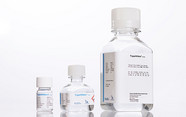The Trump Effect on Cell and Gene: Science versus Shockwaves
Audrey Greenberg on FDA staffing cuts, Peter Marks’ resignation, CDMO pressure, IP migration, AI acceleration, and what CGT needs now to stay on track.
| 9 min read | Interview

With regulatory turmoil, NIH funding caps, AI strategy pivots, sweeping leadership resignations, and unprecedented restructuring across US healthcare agencies, the cell and gene therapy (CGT) sector finds itself in a pressure cooker. Audrey Greenberg, CEO of AG Capital Advisors and Founding Co-Host of the Advanced Therapies Think Tank, discusses how the industry can protect progress, and where we go from here.
How would you describe the current environment for CGT in the US?
This is a recalibration moment. The science is delivering, but the commercial model is straining. Cell and gene therapies are pushing medicine forward in ways that were unimaginable a decade ago. But the business challenges – scale-up, reimbursement, global regulatory fragmentation, and manufacturing complexity – are still significant.
What investors are watching now isn’t just the science, it’s the economics. Can we reduce the cost of goods? Can we streamline autologous manufacturing? Can we make in vivo delivery real? The capital markets want more than potential; they want predictability.
At the same time, global regulators are moving at different speeds, and access remains uneven. CGT still represents a once-in-a-generation shift in how we treat disease, but getting from innovation to impact now requires a very deliberate strategy.
What impact could a second Trump administration have on the future of CGT?
It depends which version shows up. The first Trump term saw deregulation, accelerated pathways, and pro-business rhetoric, but also volatility, agency churn, and science politicization.
For CGT, the risk isn’t about red versus blue – it’s about stability versus uncertainty. This field needs regulatory clarity, consistent leadership at agencies like the FDA and HHS, and investment in infrastructure and workforce. If we see renewed disruption – especially if leadership turnover slows progress at the Center for Biologics Evaluation and Research (CBER), part of the FDA that regulates biological products including CGTs, reporting up through HHS) or undermines trust in the approval process – it could set the field back.
That said, there’s also an opportunity: a new administration could double down on American biomanufacturing, genomic innovation, and AI integration. But the industry will need to advocate loudly and stay laser-focused on facts, outcomes, and patient impact – not headlines.
What’s the administration’s position on AI, and does it matter for CGT?
Yes. And it's an emerging storyline. The administration has launched several AI initiatives to ensure ethical deployment of artificial intelligence in healthcare and biopharma. But the regulatory framework is still evolving, and CGT companies are left wondering how AI-enabled trial design, manufacturing optimization, or safety modeling will be reviewed by agencies like the FDA.
We need a clear, proactive position from the FDA and CBER on AI integration – especially as more CGT companies rely on machine learning to model vector behavior, improve QC, and streamline clinical trial protocol development. If the administration wants to lead in both AI and biotech, it needs to develop parallel guidance for where the two intersect.
We’re also seeing early use of AI-generated biologic design and digital twin modeling for bioprocessing. Those are areas where regulatory clarity is years behind the tech.
What’s happening at CBER, and what’s at risk if that progress stalls?
The resignation of Dr. Peter Marks is a huge loss for the field. He’s been a tireless advocate for advanced therapies and a steady hand during moments of incredible scientific and political turbulence. His leadership helped drive forward platform-based regulatory models, accelerated review processes, and strengthened CBER’s CGT infrastructure.
CBER made tremendous strides under Marks, who had led the center since 2016 and deeply understood the complexities of CGT. One of the most promising developments is the exploration of platform-based regulatory frameworks, which could allow modular approvals across similar products, reducing duplication and time to market.
Fortunately, strong internal leadership remains. Dr. Nicole Verdun, Director of the Office of Therapeutic Products, continues to bring deep hematology and regulatory expertise, with a focus on improving review efficiency and industry engagement. Her presence offers important continuity.
Still, the loss of Marks underscores how vulnerable scientific progress can be to political instability. It’s a clear signal that the industry must double down on speaking with one voice, standing up for regulatory independence, and protecting the infrastructure and leadership that enable innovation.
If CBER loses momentum, whether due to budget constraints, political pressure, or internal turnover, that progress could evaporate.
HHS just announced plans to cut 10,000 jobs, including 3,500 at the FDA. How serious is this for CGT?
Very serious. Even if direct drug reviewers are “protected”, CGT depends on an ecosystem of regulatory support – everything from compliance and inspections to data infrastructure and project coordination.
With a therapy class this complex, delays in FDA meeting minutes, IND responses, or BLA reviews aren’t just inconvenient – they’re existential. Companies may face unpredictable timelines, and smaller biotechs in particular could suffer.
We need the FDA to be stronger, not leaner. Efficiency doesn’t come from slashing staff – it comes from stable funding, clear mandates, and partnership with industry.
If there are regulatory slowdowns, CGT companies should plan for turbulence. Build buffers into timelines. Over-resource your regulatory teams. Engage early and often with the FDA, and make sure your CMC and clinical documentation is bulletproof.
Also, invest in policy literacy. The smartest companies right now are the ones mapping out how changes at the FDA, CMS, NIH, and even AI policy will impact development and commercialization two to three years out.
There’s been talk of CGT IP being developed in China and licensed to the US. Is this a real trend?
Yes – and it’s accelerating. Chinese companies, many with government subsidies, are developing CGT platforms that are now being licensed into the US. It’s a reversal of the historic model, where US biotech was the IP engine for global markets.
I’m all for collaboration, but we need to protect American innovation. That means incentives for domestic R&D, manufacturing infrastructure, and fair trade practices. If we don’t secure our ecosystem, we risk becoming a secondary market for therapies we should be leading.
What about the NIH’s proposed 15 percent cap on indirect costs – what’s the potential fallout?
This is one of those quiet policy shifts with huge downstream effects. Indirect costs fund the infrastructure that allows universities and academic medical centers to run clinical research. Cap those costs too tightly, and you undermine the labs that fuel our biotech pipeline.
It will weaken tech transfer, shrink the pool of early-stage innovation, and increase pressure on already-strained institutions. Academic labs are often where the first CGT breakthroughs happen. If we don’t support them, the whole innovation chain suffers.
What about emerging “multi-omic” trends? How do they fit into the CGT future?
Multi-omic technologies – including genomics, proteomics, and metabolomics – are creating unprecedented opportunities to understand patient biology at a granular level. That granularity is critical for CGT, where precision matters more than ever.
The ability to integrate omics data into patient selection, target identification, and manufacturing control could radically improve efficacy and reduce adverse events, but there’s still a lack of regulatory clarity around how this data will be reviewed and validated.
It’s another case where science is ahead of policy. We need the FDA and global regulators to work with industry on defining standards for multi-omic integration in clinical trials.
Does the Inflation Reduction Act (IRA) impact CGT?
Not in the way it impacts traditional therapeutics. The IRA targets high-volume, chronic-use drugs under Medicare, and most CGTs don’t fall into that bucket. They tend to treat rare diseases with small patient populations and short treatment durations.
That said, IRA has amplified investor sensitivity around pricing models – that affects CGT indirectly. The real pressure points in CGT are cost of goods, value-based reimbursement models, and clarity around long-term access. That’s where we need policy innovation, not just protection.
Do you see a role for public-private partnerships in sustaining CGT infrastructure?
Absolutely. CGT manufacturing, workforce training, and supply chain resilience all benefit from aligned public-private investment. We've seen success with ARPA-H, BARDA, and some NIH consortia, but we need to go bigger.
Think: shared GMP infrastructure, translational hubs, or data-sharing collaboratives for long-term follow-up studies. The government has a role to play in de-risking the early infrastructure required for a viable CGT ecosystem, and industry needs to step up with smart co-investment.
What role does real-world evidence (RWE) play in CGT and is the regulatory system keeping pace?
RWE is critical in CGT because traditional trial designs often aren’t feasible or ethical. Small populations, curative endpoints, and long-tail safety profiles mean we need better systems for post-market data collection.
But while regulators are embracing RWE conceptually, implementation remains inconsistent. There’s no gold standard yet for how RWE is collected, validated, or submitted across CGTs. The field would benefit from harmonized guidance, especially as more one-time therapies move into rare disease indications with limited trial windows.
Are global regulatory standards diverging? What’s the impact on CGT?
There’s growing divergence in how regulators handle CGT globally. The EU, UK, and Japan’s agencies are experimenting with new frameworks. The US still leads, but if we don’t modernize consistently, we risk becoming less competitive. Companies may start designing trials for faster-to-approve jurisdictions. That’s a wake-up call: regulatory leadership isn’t a given, it’s earned.
What does the CGT industry need to prioritize over the next 12-18 months to maintain investor confidence under the current administration?
With the Trump administration back in office, we’re seeing a return to pro-business rhetoric, agency reshuffling, and potential deregulation. For investors, that creates both tailwinds and turbulence. CGT companies need to stay focused on execution.
That starts with three things:
- Platform-first thinking – Investors are looking for scalable, repeatable technology, not one-time therapies that are hard to commercialize.
- Manufacturing transformation – The field needs to shift from bespoke processes to cost-efficient, scalable models – whether through automation, in vivo delivery, or allogeneic platforms.
- Reimbursement strategy – Demonstrating early payer engagement and economic value is now table stakes.
Beyond the boardroom, however, we need to unify as an industry. That means a coordinated message to policymakers around regulatory clarity, manufacturing incentives, and reimbursement innovation. It also means investing in workforce development because CGT doesn’t scale without people trained to build and run these platforms.
Finally, we need to lead the narrative. CGT is delivering hope and cures. That message has to rise above the politics. The companies that do this well – those who balance scientific rigor with commercial realism – will continue to earn capital and drive impact.



















